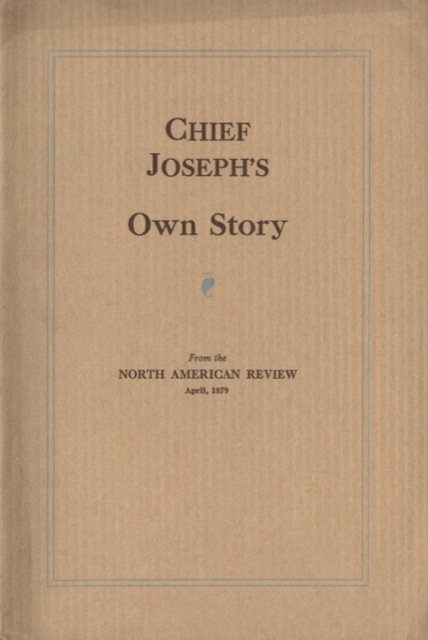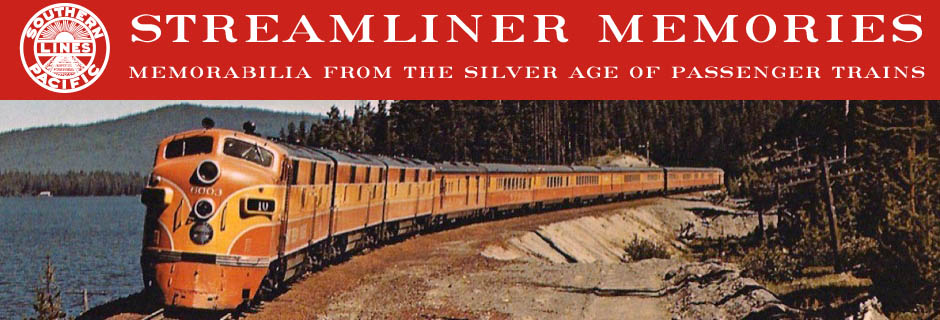On July 19 the Upper Missouri Special arrived in Havre at 8 am, where expedition members made an auto trip to the site of the last battle of Chief Joseph’s Nez Perce Indians, about 15 miles south of the Great Northern line. This battle ended one of the most dramatic epics in the Old West, in which a band of about 800 otherwise peaceful Indians resisted being located on a reservation by fleeing their homes in northeastern Oregon and traveling nearly 1,200 miles while being chased by the U.S. Army.

Click image to download a 10.5-MB PDF of this booklet, most of which was reprinted from the North American Review.
The story actually began in 1855, when Chief Joseph’s father, Joseph the Elder, was the leader of one of several Nez Perce bands who signed a treaty agreeing to accept a 7.7-million-acre reservation in western Idaho and northeastern Oregon. Just eight years later, however, the federal government asked the tribe to accept a reservation of less than a million acres in north central Idaho. Some of the bands agreed, but others, including Joseph’s, did not. Initially, the army did not try to force the non-treaty bands to move, but neither did it stop whites from settling on Nez Perce lands.
Army policy changed in 1877, and General Oliver Howard ordered the non-treaty bands to move. Joseph’s band and another band decided to seek asylum in Canada, where Chief Sitting Bull had moved. This resulted in a three-and-one-half month journey punctuated by seven battles, all of which the Indians won until the eighth, final battle. Joseph was not “the chief” or even a war chief (all accounts of his battlefield genius are simply wrong), but merely one of the band’s chiefs. The war chiefs naively believed that, having lost each battle, the army would stop its pursuit. They repeatedly allowed the bands to make extended camps, giving the army opportunities to regroup and catch up.
Finally, during another extended stop, the army surrounded the band just a day’s travel from Canada. After a five-day battle during an October snowstorm that probably killed as many Nez Perce as the army, Joseph–one of the last surviving chiefs–surrendered. His poetic words of surrender–“I will fight no more forever”–were taken down by Charles Erskine Scott Wood, who himself was a poet, and some historians suspect Wood substituted his own words for Joseph’s.
As punishment for their resistance, the surviving Nez Perce were roughly relocated to Indian Territory (now Oklahoma). In 1879, Joseph traveled to Washington DC where he asked to be allowed to return to Oregon. His moving statement was published in the April, 1879 issue of North American Review, then one of the nation’s leading monthly magazines. Joseph’s appeal was nevertheless unsuccessful, largely due to opposition from whites who had moved onto former Nez Perce lands in northeastern Oregon where, ironically, they named a town after him.
The army never allowed Joseph to return to Oregon, or even to the Nez Perce reservation in Idaho which uses Joseph’s image on its logo today. Shortly before he died in 1904, however, Joseph went to Seattle where he became friends with University of Washington historian Edward Meany. Meany was able to join the Great Northern’s 1926 expedition, where he presumably gave expedition members a first-hand account of what Joseph was like.
The Great Northern distributed a reprint of Joseph’s statement (which erroneously gives the year as 1897) to expedition members. At the site, the group heard speeches by Major-General Scott, who had known General Nelson Miles, the American general who chased the Nez Perce. Charles Smith, one of the participants in the battle, also recounted his experiences and suggested that Congress should designate the site a national monument. The group returned to Havre by noon, when the the train left for East Glacier where expedition members settled into Glacier Park Lodge, where they would stay the next three nights.
